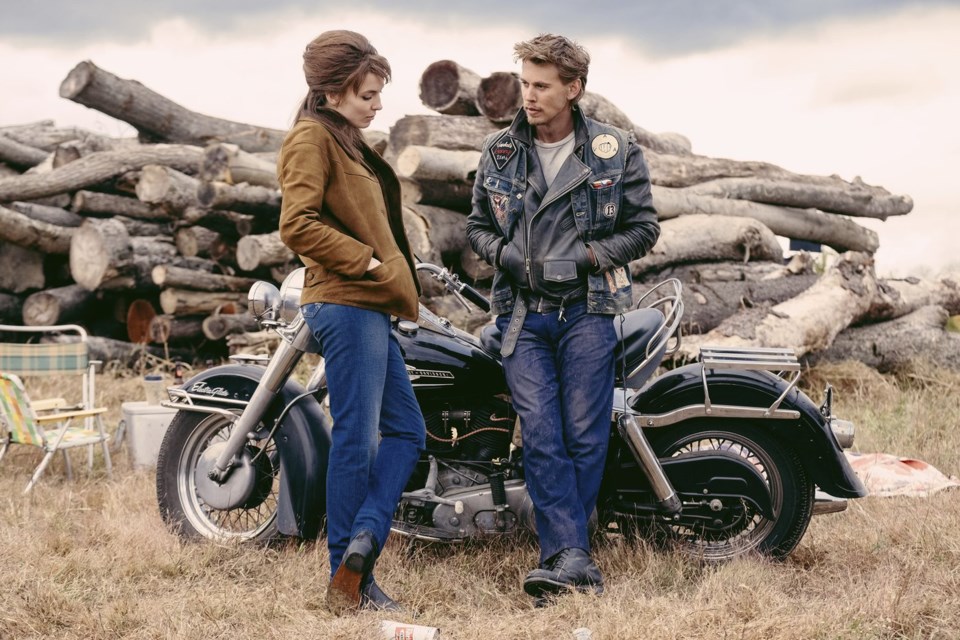Still images have been a source of wonder and mythology in the films of
āMud,ā Nicholsā Twain-soaked Mississippi fable, seemed derived from the magical sight of a boat held aloft by a tree. about a ā60s interracial marriage, took inspiration from tender Life magazine photographs taken of the real-life couple. Nicholsā latest, is based on photographer for which he spent four years with a Chicago motorcycle club.
Itās not hard to see what Nichols saw in Lyonās black-and-white stills. Thereās the stylish raw materials ā the chrome bikes, the slicked back hair, the black leather jackets. But thereās also a just emerging antiauthoritarian, easy-riding spirit and camaraderie. Like the central figures of āL“Ē±¹¾±²Ō²µ,ā they are classically drawn outsiders who encapsulate something glorious and uneasy about freedom in America.
In the exhilarating first half of āThe Bikeriders,ā which opens in theaters Friday, Nichols is less compelled to build a narrative around his bike gang, the Vandals (based on the Outlaws) than summoning an intoxicating atmosphere reminiscent of those old photographs. āThe Bikeridersā eventually becomes saddled with heavier plot mechanics ā you can almost sense his riders growing weary from having to strap narrative devices onto their bikes. The movie wants to ride, but itās not sure how much story to pack for the trip. But this is a vivid dramatization of the birth of an American subculture.
The framing device Nichols settles on is Lyon, himself, played by Mike Faist, whoās conducting interviews for his book. His conversations with a woman named Kathy ( ) bookend and sporadically narrate the movie.
Kathy, also based on a real person, seems at first an unlikely spokesperson for the gang. She speaks with a thick Illinois accent (an actorly distraction throughout) and has no affection for motorcycle riders. But one night at a bar, she sees Benny ( ) across the smokey room and, even if she doesnāt admit it at that moment, falls for him. Again, itās not hard to see why. Butler is by now but the suppleness with which he can sink into mid-century America is no less apparent. Benny drives Kathy home, parks his bike outside the place and patiently waits for her boyfriend to skip town.
Nichols, a devotee of films like āHudā and āCool Hand Luke,ā is a filmmaker who works very consciously within classic American idioms. In Butler he has his James Dean, making Tom Hardy his Marlon Brando. Hardy plays Johnny, Bennyās best pal and the one who starts up and presides over the Vandals. (The āwhaddya gotā clip of Brando from āThe Wild Oneā is even briefly seen on a small TV in āThe Bikeriders.ā)
The Vandals, as a club, start about as simply as kids might call a tree house to order. Theyāre a bunch of guys who like riding motorcycles and like talking about them. Simple as that. But men come like moths to a flame, attracted by the tough lifestyle, the cool jackets with patches and a way out of mainstream America. Among them are Cal (Boyd Holbrook), Cockroach (Emory Cohen), Funny Sonny (Norman Reedus) and Zipco (Michael Shannon).
āObscenity and motorcycles travel hand in hand,ā someone says, with pride.
The early days of the group are, it would seem, a lot of fun. Barroom brawls and riding carefree through corn fields. Most of these guys donāt have much, but they have each other. And their loyalty is total.
Kathy isnāt so sure sure. She watches the growing gang ā a completely male bunch ā with skepticism and fear for Benny. (In a scene teased in the filmās opening, heās beaten badly enough to be hospitalized.) Sometimes, they throw down purely for fun. They are the original Fight Cub.
But soon, Kathy isnāt the only one with doubts at what theyāve created. As their gang grows, what the Vandals embody is less clear, even to Johnny and Benny. Some of the new entrants are coming straight back from Vietnam. Their old hijinks give way to more serious crimes. In one chastening scene, Kathy finds herself very nearly assaulted by its members. The gang ā and all its posturing of toughness ā begins to feel more like a trap for even its leader. Benny is drawn into a choice between the Vandals and Kathy. The homoerotic subtext is understated but not ignored; when Benny and Johnny discuss their future together, they do it gently and intimately, in the dark, like a secret confession.
As the Vandals' original ideals disintegrate, it can feel like āThe Bikeridersā gets locked into a familiar āGoodfellasā-like structure, but with a telling shift in narrator for a drama that's ultimately about masculinity. This is a movie thatās juggling a lot of contradictory ambitions. It wants to be authentic but it wants to tell a grand America saga. It wants mythology but also naturalism. Itās those instincts that have made Nichols one of the most essential filmmakers of his generation, even if the results have sometimes been underwhelming by a hair. Even his best, most firmly rooted films (āTake Shelter,ā āMudā) strive for a balancing act that can be elusive.
But I think itās those dual impulses ā and, again, all the cool jackets ā that makes āThe Bikeridersā work. The movie is unabashedly romantic about the Vandals but itās equally dubious about the rugged masculinity they embody, too. āThe Bikeridersā has its hands firmly on the throttle just it does the brakes.
āThe Bikeriders,ā a Focus Features release, is rated R by the Motion Picture Association for language throughout, violence, some drug use and brief sexuality. Running time: 116 minutes. Three stars out of four.
___
Follow AP Film Writer Jake Coyle at:
Jake Coyle, The Associated Press



